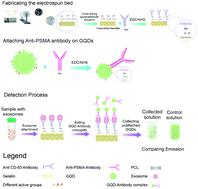当前位置:
X-MOL 学术
›
Anal. Methods
›
论文详情
Our official English website, www.x-mol.net, welcomes your
feedback! (Note: you will need to create a separate account there.)
Highly efficient detection of cancer-derived exosomes using modified core-shell electrospun nanofibers as a capture substrate and antibody immobilized-graphene quantum dots as a signaling agent.
Analytical Methods ( IF 2.7 ) Pub Date : 2020-07-06 , DOI: 10.1039/d0ay00944j Fatemeh Barati 1 , Ayyoob Arpanaei , Matin Mahmoudifard
Analytical Methods ( IF 2.7 ) Pub Date : 2020-07-06 , DOI: 10.1039/d0ay00944j Fatemeh Barati 1 , Ayyoob Arpanaei , Matin Mahmoudifard
Affiliation

|
In the past few years graphene quantum dots (GQDs) have been used as a signaling agent for medical diagnosis. They can be modified and labeled with different macromolecules to give them potential to be attached to a specific target. Herein GQDs were labeled with an antibody which is specific for cancer-derived exosomes, isolated from blood serum by using a specialized PCL–gelatin core–shell NFM. This membrane showed excellent sensitivity for isolating exosomes from a complex mixture such as serum, and the GQD–antibody complex detected the isolated exosomes with great sensitivity. The final results allow this method to be considered as one that can be used to quantify the concentration of a desired analyte in a mixture.
中文翻译:

使用修饰的核壳电纺纳米纤维作为捕获底物,并将抗体固定化的石墨烯量子点用作信号传导剂,可高效检测源自癌症的外泌体。
在过去的几年中,石墨烯量子点(GQD)已被用作医学诊断的信号传递剂。可以对它们进行修饰并用不同的大分子标记,使它们有可能与特定靶标连接。在此,GQDs标记了一种对癌症衍生的外泌体特异的抗体,通过使用专门的PCL-明胶核-壳NFM从血清中分离出来。这种膜对从复杂混合物(例如血清)中分离外泌体显示出极好的敏感性,而GQD-抗体复合物对分离出的外泌体具有很高的灵敏度。最终结果使该方法被认为是一种可用于量化混合物中所需分析物浓度的方法。
更新日期:2020-07-23
中文翻译:

使用修饰的核壳电纺纳米纤维作为捕获底物,并将抗体固定化的石墨烯量子点用作信号传导剂,可高效检测源自癌症的外泌体。
在过去的几年中,石墨烯量子点(GQD)已被用作医学诊断的信号传递剂。可以对它们进行修饰并用不同的大分子标记,使它们有可能与特定靶标连接。在此,GQDs标记了一种对癌症衍生的外泌体特异的抗体,通过使用专门的PCL-明胶核-壳NFM从血清中分离出来。这种膜对从复杂混合物(例如血清)中分离外泌体显示出极好的敏感性,而GQD-抗体复合物对分离出的外泌体具有很高的灵敏度。最终结果使该方法被认为是一种可用于量化混合物中所需分析物浓度的方法。











































 京公网安备 11010802027423号
京公网安备 11010802027423号